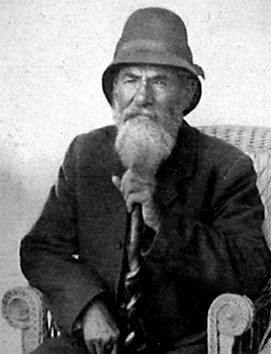Marthinus Prinsloo facts for kids
Quick facts for kids
Marthinus Prinsloo
|
|
|---|---|
 |
|
| Commander-in-chief of the Orange Free State | |
| Personal details | |
| Born | 9 October 1838 Graaff-Reinet district, Western District, Eastern Cape, South Africa |
| Died | January 31, 1903 (aged 64–65) Winburg, Orange Free State, South Africa |
| Nationality | Afrikaner |
| Spouse | Elsie Petronella Jacoba Botha |
| Profession | Farmer, Boer general, politician, judge |
| Military service | |
| Allegiance | |
| Years of service | 1867–1902 |
| Commands | Winburg Kommando, Orange Free State commander-in-chief |
| Battles/wars | Free State–Basotho Wars, Second Boer War |
Marthinus Prinsloo (1838 – 1903) was an important figure in the Orange Free State. He was a Boer farmer, a politician, and a general during the Second Boer War (1899-1902).
Prinsloo was born in 1838 in the Graaff-Reinet district of South Africa. His parents, Nicolaas Frans Prinsloo and Isabella Johanna Petronella Rautenbach, later moved to the Orange Free State. They lived in places like Bloemfontein, Waterval, and Bethlehem.
Contents
Early Life and Public Service
Becoming a Leader
In August 1867, Marthinus Prinsloo was chosen as a field cornet. This was a local military and administrative leader. He was part of the Winburg Commando, a group of citizen soldiers. He earned this role because he fought well in the Free State–Basotho Wars.
As a reward for his bravery, he received a farm called Leeuwspruit. This farm was located in the Ladybrand district.
Family and Politics
Marthinus Prinsloo married Elsie Petronella Jacoba Botha. They had five sons and eight daughters together.
In 1876, Prinsloo became a Member of the Volksraad. The Volksraad was like the parliament or House of Assembly of the Orange Free State. He represented the area of Koranaberg in Bloemfontein. He was known as a good speaker and served on many important committees.
Later, he returned to his family farm, Waterval. In 1883, he was again elected to the Volksraad, this time representing Taaiboschspruit (Winburg). He also continued to lead the Winburg Commando. He even served as a justice of the peace, helping to settle local disputes.
In 1889, Prinsloo decided to retire from public life. He bought a wealthy farm called Vredepoort near Kwestiefontein (Bloemfontein).
Role in the Second Boer War
Leading the Orange Free State Army
The Second Boer War began in 1899. On October 2, 1899, the Orange Free State called its citizens to arms. The commandos (citizen armies) from several Boer towns chose Prinsloo as their Commandant-General. This meant he would lead the Orange Free State army into Natal.
He took part in the siege of Ladysmith, which lasted from November 2, 1899, to February 28, 1900. During this time, he fought in several battles.
Key Battles and Challenges
On January 6, 1900, Prinsloo and General Schalk Burger led an attack. They tried to capture strongholds called Caesar's Camp and Wagon Hill near Ladysmith. However, they were later criticized for not giving clear directions during this attack.
After the Battle of Spion Kop in January 1900, Prinsloo was in charge of the front lines along the Tugela River. When the British finally relieved Ladysmith on March 1, 1900, Prinsloo then commanded troops at Van Reenen's Pass.
Later, the president of the Orange Free State, Martinus Theunis Steyn, asked Prinsloo to temporarily lead the Orange Free State troops in the Brandwater Basin. This area is in the eastern part of the Free State.
The Surrender of Prinsloo's Forces
Prinsloo and his men were guarding the mountain passes of the Drakensberg mountains. Other Boer generals, like Christiaan de Wet, Paul Roux, and Jonathan Crowther, tried to retreat with their troops. De Wet managed to escape with President Steyn.
However, the remaining army failed to defend Slabbert's Nek pass. They also lost Retief's Nek after a battle on July 23–24, 1900. The British army surrounded Prinsloo. They blocked all the mountain passes, including Witnek, Kommandonek, Noupoortsnek, and Golden Gate pass.
Because they were completely surrounded, Prinsloo felt he had no choice but to surrender. On 30 July 1900, he and his army surrendered to General Archibald Hunter. About 4,300 of his soldiers, including Prinsloo, Roux, and Crowther, were taken as prisoners of war near Fouriesburg. Most of them surrendered at a place now known as Surrender Hill.
This was the largest number of Boer soldiers captured in the war up to that point. It was even more than the 4,000 captured when General Piet Cronjé surrendered at the Battle of Paardeberg earlier that year. Most of Prinsloo's captured soldiers were sent to India. Prinsloo himself was held captive at Simon's Town.
After the war ended, Marthinus Prinsloo returned to his farm. He passed away in 1903.
Images for kids
-
1986 Surrender Hill monument, beside the Clarens-Fouriesburg road in the eastern Orange Free State, South Africa. Photograph 2011.






